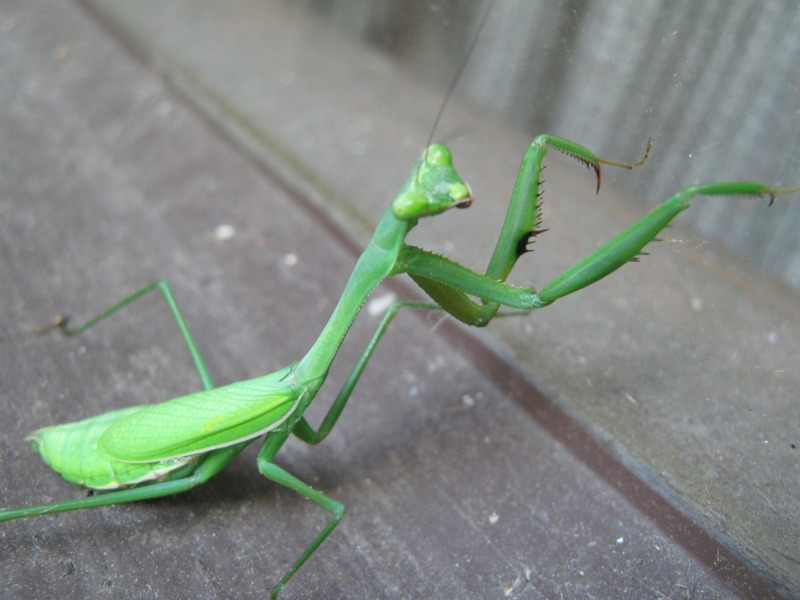
European Mantis Facts
- Intriguingly, the term of European Mantis serves as one of the common names of a particularly large variety of the amazing mantis. However, this extremely fascinating insect also goes by the other frequently used common name of the praying mantis.
- It’s perhaps also of interest that many people often employ the latter term for all types of mantises, regardless of origin. Meanwhile, the scientific name of this extremely impressive creature remains the relatively simple to pronounce Mantis religiosa.
- Regardless of which term used to refer to it, this species, like most of its relatives, often fascinates many people. In point of fact, quite often, this species represents the archetype of all mantises, in the minds of individuals, when polled on the topic.
- Intriguingly, although not endemic to North America, this remarkable arthropod eventually became introduced into the region. Although no proof exists, many experts believe this introduction occurred accidentally, via shipping containers.
- It’s also believed that this introduction, whether it was accidental or otherwise, occurred near the end of the 19th century. Regardless of how it occurred though, it has now spread incredibly. This has had a beneficial result for it.
- Quite fortunately, the incredible European Mantis appears to be maintaining a sufficiently stable population. This further appears to be true throughout the majority of its range. This places it in the small group of species to make that claim.
- The IUCN,therefore, presently lists it as Least Concern. This status appears on the organization’s Red List of Threatened Species. Like many species, this animal nevertheless may be considered to be at risk, due to the effects of climate change.
Related Articles
Ghost Mantis
European Mantis Physical Description
Although not the largest of all known mantids, the gorgeous European Mantis nevertheless stands out from the crows. In point of fact, it does rank among the larger varieties. However, differences in physical sizes quite frequently occur among individuals.
But, this holds true due to a remarkably common trait. That’s the fact that this species, like most related creatures, displays a certain physiological tendency. This holds true since it shows a moderate degree of the characteristic of sexual dimorphism.
In this variety, the females attain a greater length and weight than the male. Firstly, the female achieves a length averaging between 2.75 – 3.5 in (7 – 9 cm). Secondly, in addition to a thinner shape, the male only reaches an average length of 2.4 – 2.75 in (6 – 7 cm).
The coloring of the European Mantis also varies among individuals. Gender plays no apparent role in this pattern, however. The shades displayed by individuals also differ. The basic pattern consists of shades of brown, green, and yellow. But, a few display a dark black.
- Kingdom: Animalia
- Phylum: Arthropoda
- Class: Insecta
- Order: Mantodea
- Family: Mantidae
- Genus: Mantis
- Species: M. religiosa
European Mantis Distribution, Habitat, and Ecology
Although the stunning European Mantis, as the name indicates, originated in southern Europe, in now inhabits a broad swathe of the world. In addition to areas in which it was introduced, the arthropod also spread naturally to several other regions of the globe.
Due to that spreading, it now naturally inhabits much of the continents of Africa and Asia. Man also introduced it to the continent of Australia. Fortunately for it, therefore, this invertebrate displays a remarkable degree of adaptability in regards to its choice of habitat.
That holds since it inhabits a wide range of ecosystems. These include such locations as temperate and tropical forests, urban areas, and even semi-arid regions. It does, however, prefer the area it appears in to have sufficient quantities of grass and herbaceous plants.
Not surprisingly, one reason for this preference occurs due to the need for a sufficient and steady food supply. The European Mantis evolved as a powerful, carnivorous insect. The invertebrate also hunts its prey as a highly effective ambush predator.
This prey typically consists of several types of insects. These include such creatures as grasshoppers, crickets, moths, bees, and flies. Individuals of this species nonetheless also occasionally tackle significantly larger prey, such as smaller invertebrates.
Species Sharing Its Range
Check out our other articles on 4 Stupendous Stick Insects, Basking Shark, Bungle Bungles, Ghost Orchid, Pallid Bat, Inaccessible Island Rail, Flatback Sea Turtle, Purple Frog, Argentine Ant
